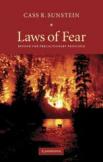In Harm's Way
Consider that cancer is the leading killer of Americans under age 85, that 40 percent of victims are under 65 and that for 25 years childhood cancers have been increasing 1.4 percent annually, mostly because of environmental contaminants. If the National Institutes of Health are right, industrial toxins annually cause thousands of heart-related deaths and at least 60,000 preventable cancer fatalities in the United States. How should society respond?
Researchers in industry-funded think tanks, like the American Enterprise Institute (A.E.I.), say people are irrational to fear pollution when more deaths180,000 annuallyare caused by smoking and drinking. They say economic growth, not growth-threatening pollution regulation, promotes more health, since wealthier groups are healthier.
Scientists from groups like the World Health Organization and the New England Journal of Medicine agree that tobacco and alcohol are major killers, yet say this is no reason to ignore more than 60,000 annual U.S. deaths from industrial toxins. They favor the 35-year-old precautionary principle, the better-safe-than-sorry view that regulators should protect against pollutants even before their harmful mechanisms are completely clear.
Attacking the precautionary principle, Cass R. Sunstein’s new book, Laws of Fear, joins the industry side of this debate. Including many papers that Sunstein wrote for the American Enterprise Institute, his book diagnoses a problem and then offers solutions to it. The problem, he maintains, is that because people are irrational victims of panic, hysteria and baseless fear of pollution, they overreact to tiny industrial risks.
Sunstein’s first two solutions are an anti-catastrophe principle, limiting regulatory precaution to potentially catastrophic pollution, and the use of cost-benefit analysis as a natural corrective to pollution fears. His third solution is libertarian paternalism, having planners use market mechanisms as sensible correctives to overly stringent pollution regulations. Citizens could depart from the default plan, allowing more pollution, provided they sometimes paid significant costs for more health protection.
While Sunstein (a University of Chicago law professor) correctly emphasizes cost-benefit analysis and clarifies the precautionary principle, his paternalistic response to alleged public irrationality undercuts human rights to knowledge, to consent and to life. He denies that individual choices should be respected, claiming freedom of choice should sometimes be denied altogether and saying that citizens should not be told about pollution risks if they would respond irrationally. Supporting protection against catastrophic pollution, Sunstein nevertheless says people must be willing to pay to avoid small industrial riskslike those that kill only 100 of every million people. Admitting that willingness to pay causes regulators to value the lives of wealthy or developed-nation citizens 10 times more than poor people’s lives, Sunstein says equal treatment harms the poor, because monies used for pollution control cannot be spent on economic production.
Sunstein says that in five areas (genetically engineered food, nuclear power, arsenic in drinking water, global warming and risks to marine mammals), the public overreacts to tiny risks.
For instance, Sunstein says people overreact to genetically engineered seeds (G.E.S.). He condemns Zambia’s palpably absurd rejection in 2002 of genetically modified corn and says it risked causing African starvation. Sunstein, however, neglects to tell readers that no commercially available G.E.S. increase yield, nutrition or drought tolerance; that 80 percent of such seeds are engineered by chemical companies to make plants resistant to otherwise lethal herbicides, like Monsanto’s Roundup, so that farmers can cut labor costs by increasing chemical use; that higher food-borne chemical residues harm humans; that the most-used G.E.S. chemical, Roundup, causes many cancers, including non-Hodgkin’s lymphoma; that G.E.S. have extinguished many developing-world crop species, caused human and animal deaths and created outbreaks of herbicide-resistant weeds, and that the European Union has banned G.E.S. At a recent U.N. Food and Agriculture Organization meeting, 18 African nations condemned G.E.S. for undermining their capacity to feed themselves. Ignoring such information, Sunstein instead uses citations only from chemical industry-funded groups like Monsanto to support his claims about G.E.S. benefits.
Something similar is the case in Sunstein’s treatment of the other instances of nuclear power of alleged public overreaction to pollutants. Ignoring classic scientific documentation, he repeatedly condemns nuclear critics as irrational, but never mentions U.S. government studies showing a 20 percent probability of a nuclear core melt in the United States, 150,000 possible deaths and Pennsylvania-sized contamination. Nor does Sunstein tell readers that because nuclear insurance is so expensive, the government (through the Price-Anderson Act) has given nuclear industries liability protection against more than 98 percent of citizens’ possible damage claims. If nuclear risks are tiny, as Sunstein claims, industry does not need Price-Anderson. If nuclear risks are catastrophic, Sunstein contradicts himself in promoting both nuclear energy and his anti-catastrophe principle.
While some people respond irrationally to the threat of industrial toxins, Sunstein’s willingness to ignore classic ethical and scientific literature, while blaming the victims of pollution, make him, not them, appear irrational. And, finally, justice is the issue. Regardless of victims’ rationality, those who profit from imposing pollution bear responsibility for its risks.
This article also appeared in print, under the headline “In Harm's Way,” in the December 5, 2005, issue.








